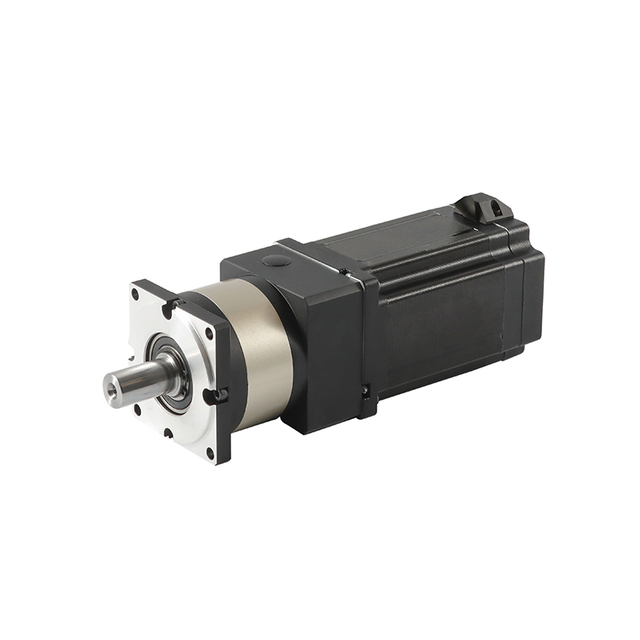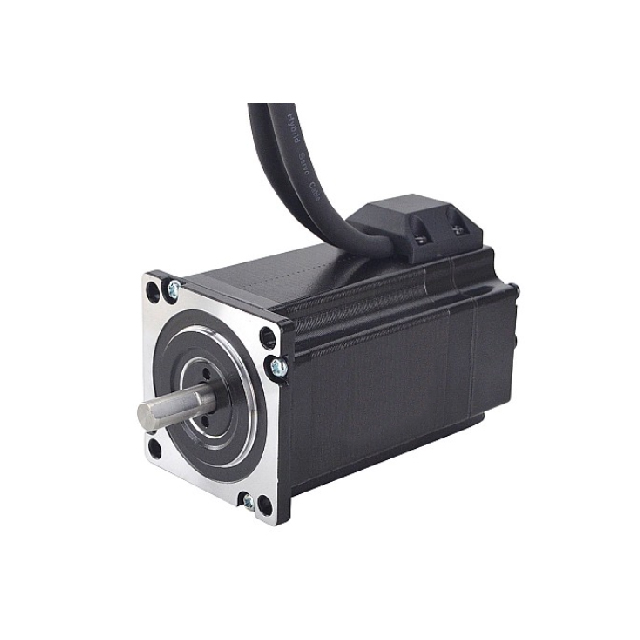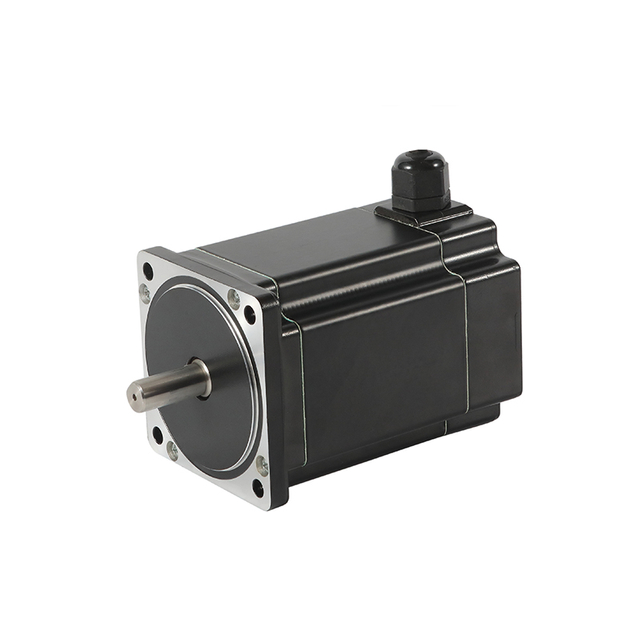
When it comes to precision motion control, stepper motors are often the go-to solution for many engineers, hobbyists, and automation designers. However, as applications demand greater accuracy, reliability, and efficiency, the question arises: Are closed-loop steppers really worth the investment? In this article, we'll explore the inner workings, advantages, drawbacks, and ideal use cases of closed-loop stepper motors to help you make an informed decision.
Understanding Closed-Loop Stepper Motors
A closed-loop stepper motor combines the simplicity of traditional stepper motors with the intelligence of a feedback system. Unlike open-loop steppers that move based on commanded steps without knowing their actual position, closed-loop systems include a rotary encoder or sensor that constantly monitors the motor shaft position.
This real-time feedback allows the driver to automatically correct position errors, adjust torque, and optimize current flow, ensuring precise control and smoother operation. Essentially, a closed-loop stepper merges the accuracy of a servo system with the predictability of a stepper.
How Closed-Loop Steppers Work
In modern motion control systems, closed-loop stepper motors have become a popular solution that combines the best qualities of stepper and servo technologies. They deliver high precision, torque efficiency, and reliability—essential attributes in automation, robotics, CNC machinery, and other demanding applications.
To fully appreciate their performance advantages, it's essential to understand how closed-loop stepper motors work, how feedback integration changes the control process, and why this makes them superior to traditional open-loop systems.
The Principle Behind Closed-Loop Operation
A closed-loop stepper motor is fundamentally a stepper motor integrated with a feedback device, usually an encoder, that continuously monitors the motor's position.
Unlike open-loop steppers, which assume the commanded motion is executed correctly, a closed-loop system constantly verifies actual motor performance. The encoder sends real-time position data back to the driver, creating a closed feedback loop that ensures the commanded and actual positions match precisely.
If any deviation or load disturbance occurs, the system detects it immediately and makes automatic corrections—maintaining perfect synchronization.
Step-by-Step Operation of a Closed-Loop Stepper Motor
The operation of a closed-loop stepper motor can be broken down into five key stages:
1. Command Input
A controller (such as a microcontroller, PLC, or motion control board) sends movement instructions to the driver. These commands specify the number of steps, speed, and acceleration needed for the task.
2. Motor Activation
The driver energizes the motor windings sequentially, creating magnetic fields that pull the rotor toward precise step positions. Each pulse corresponds to a specific angular movement—typically 1.8° per step for a standard motor.
3. Real-Time Position Sensing
As the rotor moves, an encoder mounted on the shaft generates digital feedback signals that represent the motor's actual position and speed. The encoder typically outputs incremental or absolute signals depending on system requirements.
4. Comparison and Correction
The driver continuously compares the target position (commanded) with the actual position (feedback).
If both match, the system continues normal operation.
If there's any position error, such as a missed step or external load disturbance, the driver instantly adjusts current and phase timing to correct it.
This rapid feedback control cycle happens thousands of times per second, maintaining near-perfect accuracy.
5. Dynamic Current Adjustment
In addition to position correction, closed-loop drivers monitor motor torque demand. They automatically reduce or increase current flow based on the load. This adaptive current control minimizes power consumption, heat generation, and mechanical stress.
Key Components of a Closed-Loop Stepper System
Understanding how each component contributes to the overall functionality provides deeper insight into why these systems perform so efficiently.
1. Stepper Motor
The core of the system, the stepper motor, operates in discrete angular increments. It converts electrical pulses into precise mechanical motion without the need for continuous position sensing—though in closed-loop mode, it benefits from encoder feedback for correction.
2. Encoder
The rotary encoder is the heart of the feedback system. Mounted on the motor shaft, it detects both rotational position and direction.
Common encoder types include:
3. Driver (Controller)
The driver acts as the brain of the system, interpreting control signals, managing current flow to the motor coils, and processing encoder feedback.
Modern closed-loop drivers integrate PID (Proportional-Integral-Derivative) or vector control algorithms to achieve stable and precise motion under varying loads.
4. Control Interface
This is typically a PLC, motion controller, or microcontroller that sends step and direction signals to the driver. It defines movement parameters such as speed profiles, acceleration ramps, and target positions.
The Feedback Control Loop Explained
The term “closed-loop” comes from the continuous feedback loop between the encoder and the driver. Let's examine this loop in detail:
Command Phase: The controller sends a target position (desired steps).
Motion Phase: The motor rotates toward the commanded position.
Sensing Phase: The encoder reports actual position and speed.
Comparison Phase: The driver compares target and actual values.
Correction Phase: If discrepancies are found, the driver corrects the motion by adjusting current and phase angles.
This closed feedback loop allows the system to self-correct in real time, eliminating one of the biggest weaknesses of open-loop systems—missed steps.
The result is a high-performance motor capable of maintaining accuracy even under sudden load changes or high acceleration demands.
Control Modes in Closed-Loop Steppers
Modern closed-loop systems often support multiple control modes for flexibility:
1. Position Control Mode
Used when exact positioning is required (e.g., CNC machines, robotic arms). The driver ensures the shaft moves to and holds a defined position.
2. Velocity Control Mode
The motor speed is controlled based on feedback from the encoder. This mode is ideal for conveyor belts or pumps that require constant speed operation.
3. Torque Control Mode
Here, the driver regulates torque output while monitoring load feedback. This is particularly useful in tensioning, pressing, or winding applications.
Benefits of Closed-Loop Stepper Operation
1. Absolute Position Accuracy
Encoder feedback guarantees accurate motion, virtually eliminating missed steps or cumulative errors common in open-loop control.
2. High Torque Utilization
By dynamically adjusting current based on load demand, closed-loop systems achieve greater torque efficiency—especially at higher speeds.
3. Reduced Heat Generation
Since the driver only supplies the necessary current, the motor operates cooler and more efficiently, extending its lifespan and reducing cooling requirements.
4. Fast Response and Acceleration
Feedback allows for faster acceleration and deceleration profiles without losing synchronization, making the motor more agile in dynamic applications.
5. Energy Savings
Lower average current draw results in energy-efficient operation, an important factor in large-scale or battery-powered systems.
Closed-Loop vs. Servo System Operation
Although both use feedback control, closed-loop steppers differ from servo motors in several key ways:
| Aspect | Closed-Loop Stepper | Servo Motor |
| Control Type | Step-based with encoder feedback | Continuous feedback |
| Torque at Low Speed | High | Moderate |
| Response Time | Fast | Very fast |
| Complexity | Moderate | Higher |
| Cost | Lower | Higher |
| Best Use | Position-critical and mid-speed tasks | High-speed, dynamic systems |
Closed-loop steppers are often called “servo-like steppers” because they provide servo-level performance without the complexity or cost associated with full servo systems.
Conclusion
Closed-loop stepper motors revolutionize motion control by merging the precision and simplicity of stepper technology with the intelligence of real-time feedback. Their ability to self-correct position errors, optimize current consumption, and deliver consistent torque makes them ideal for high-precision, high-reliability applications.
Whether used in CNC machines, robotics, 3D printers, or automation systems, understanding how closed-loop stepper motors work is key to unlocking their full potential and designing smarter, more efficient motion solutions.
Key Advantages of Closed-Loop Stepper Motors
1. No Missed Steps or Position Loss
Open-loop steppers can lose synchronization when overloaded or accelerated too quickly. Closed-loop versions prevent this by continuously verifying position accuracy, ensuring the motor never skips a step, even under dynamic loads.
2. Higher Torque and Efficiency
Traditional stepper motors often draw maximum current at all times, leading to unnecessary heat generation. Closed-loop systems dynamically adjust current based on load, delivering up to 30% more torque while consuming less power.
3. Reduced Heat and Noise
By supplying only the current needed at each moment, closed-loop steppers operate cooler and quieter. This improves motor longevity and reduces the need for additional cooling mechanisms—critical in compact automation setups.
4. Faster Acceleration and Deceleration
The feedback loop allows the system to adapt quickly to changing loads and speeds, resulting in faster response times and smoother motion profiles. This makes closed-loop systems ideal for high-speed applications requiring both torque and precision.
5. Automatic Error Detection
The built-in feedback mechanism enables real-time fault detection, alerting users to potential mechanical jams, overloads, or misalignments. This reduces downtime and maintenance costs in industrial environments.
Comparing Open-Loop vs. Closed-Loop Stepper Motors
| Feature | Open-Loop Stepper | Closed-Loop Stepper |
| Position Feedback | None | Encoder-based |
| Accuracy | Moderate | High |
| Missed Steps | Possible | Eliminated |
| Torque Output | Constant (max current) | Adaptive (dynamic current) |
| Efficiency | Lower | Higher |
| Noise & Heat | Higher | Reduced |
| Cost | Lower | Higher |
| Applications | Simple, low-load | High-precision, dynamic load |
While open-loop systems remain cost-effective and reliable for basic positioning tasks, closed-loop steppers excel where precision, speed, and reliability are essential.
Applications Where Closed-Loop Steppers Excel
1. CNC Machines and 3D Printers
In CNC routers and 3D printers, missing even a single step can ruin an entire project. Closed-loop systems ensure flawless accuracy, especially during high-speed or multi-axis operations.
2. Robotics
Robots require both speed and precision to perform complex tasks. Closed-loop steppers deliver servo-like performance at a lower cost, making them ideal for robotic arms and automated pick-and-place systems.
3. Medical and Laboratory Equipment
Devices like syringe pumps, diagnostic instruments, and precision scanners benefit from the low vibration, quiet operation, and accuracy of closed-loop motion systems.
4. Packaging and Labeling Machines
In packaging lines, synchronization and timing are critical. Closed-loop systems maintain consistent torque and prevent product misalignment due to load variation.
5. Textile and Printing Machines
Textile machinery and high-speed printers rely on stable, smooth operation—something closed-loop steppers achieve effortlessly, even under continuous operation.
Are Closed-Loop Steppers Worth the Cost?
In the world of precision motion control, choosing the right motor technology can make or break a system's performance. While open-loop stepper motors have long been favored for their simplicity and affordability, closed-loop stepper motors are rapidly gaining traction for their superior accuracy, efficiency, and reliability.
But one question often arises among engineers and designers: Are closed-loop steppers worth the extra cost? To answer that, we need to examine their operation, performance benefits, and long-term value compared to traditional open-loop systems.
Comparing Cost vs. Performance
At first glance, closed-loop steppers are more expensive due to the additional encoder and sophisticated driver electronics. However, their advantages often offset this higher initial cost through improved performance and reduced operational expenses.
Let's look at the key differences that influence cost-effectiveness.
| Feature | Open-Loop Stepper | Closed-Loop Stepper |
| Feedback System | None | Encoder feedback |
| Position Accuracy | Moderate | High |
| Torque Efficiency | Fixed current | Adaptive current |
| Heat Generation | High | Low |
| Energy Efficiency | Lower | Higher |
| Noise and Vibration | More pronounced | Smoother and quieter |
| Maintenance | Occasional recalibration | Minimal |
| Initial Cost | Low | Higher |
| Lifetime Cost | Moderate to high | Lower (due to reduced failures) |
When viewed over the entire lifecycle of a machine, closed-loop systems often prove more economical—especially in demanding or high-precision environments.
Key Reasons Closed-Loop Steppers Are Worth the Cost
1. Elimination of Missed Steps
Open-loop systems operate blindly—if the motor fails to complete a move due to overload or acceleration, it won't correct itself. This can lead to production errors, rejected parts, or mechanical collisions.
Closed-loop systems detect and correct such errors in real time, preventing downtime and material waste. This alone can justify the higher upfront cost in industrial or precision manufacturing settings.
2. Improved Energy Efficiency
In open-loop systems, the motor draws maximum current continuously, regardless of actual load demand. Closed-loop stepper motors, on the other hand, adjust current dynamically based on load conditions.
This results in:
Over time, this energy efficiency translates into substantial cost savings, particularly in multi-axis or 24/7 operations.
3. Higher Torque and Speed
Closed-loop steppers can maintain full torque output even at higher speeds, overcoming one of the main limitations of open-loop systems. The feedback loop ensures optimal torque distribution across all operating ranges.
This means that applications such as CNC machines, robotics, and packaging lines can achieve faster cycle times without losing precision or synchronization.
4. Reduced Heat and Maintenance
By drawing only the current required at any given moment, closed-loop systems generate less heat. Lower temperatures reduce wear on bearings, insulation, and electronics, leading to longer service life and less frequent maintenance.
Cooler operation also improves performance stability, especially in environments where thermal expansion can affect accuracy.
5. Enhanced Reliability and Safety
In mission-critical operations, reliability isn't optional—it's essential. Closed-loop steppers provide built-in fault detection and protection against issues like overloads, stalls, or mechanical obstructions.
The system can alert operators or shut down automatically before damage occurs, preventing costly repairs and downtime.
6. Superior Motion Quality
Thanks to encoder feedback, closed-loop systems deliver smoother acceleration and deceleration, with minimal vibration or resonance.
This results in:
The overall motion feels more fluid and controlled, making the system behave almost like a servo motor, but at a lower cost.
When Closed-Loop Systems Are Most Cost-Effective
While closed-loop steppers outperform open-loop systems in nearly every technical aspect, the value justification depends on the application. They are especially cost-effective when:
High precision or repeatability is required (e.g., CNC, robotics, medical devices).
Load conditions vary or the system operates at high speeds.
Downtime or errors are expensive (e.g., automated assembly lines).
Thermal efficiency and energy savings are long-term priorities.
Quiet, smooth motion is needed in sensitive environments.
In contrast, for simple, low-cost applications—such as small conveyors, indexing tables, or static load systems—an open-loop stepper may still be sufficient.
The Return on Investment (ROI) Perspective
Although a closed-loop stepper system may cost 20–40% more upfront, its operational advantages can yield a rapid return on investment.
Here's why:
Reduced scrap and rework: Accuracy prevents defective output.
Lower energy bills: Efficient current usage cuts electricity costs.
Less downtime: Real-time feedback prevents stalls and breakdowns.
Extended equipment life: Cooler, smoother operation protects components.
Many manufacturers find that the ROI on closed-loop systems is achieved within months, particularly in continuous or precision-driven operations.
Closed-Loop vs. Servo Systems: The Cost Balance
It's also worth comparing closed-loop steppers with servo motors, as they share similar control principles.
| Feature | Closed-Loop Stepper | Servo Motor |
| Speed Range | Moderate to high | Very high |
| Torque at Low Speed | High | Lower |
| Control Complexity | Simple | More complex |
| Cost | Moderate | Higher |
| Tuning Required | Minimal | Often required |
| Best Use | Precise, mid-speed motion | High-speed, dynamic motion |
Closed-loop steppers serve as a cost-effective alternative to servos, offering 80–90% of servo performance at a fraction of the price. For many mid-performance applications, they deliver the perfect balance between cost and capability.
Conclusion
So—are closed-loop steppers worth the cost?
Absolutely, yes—when your system demands accuracy, reliability, and efficiency.
The initial investment pays off quickly through lower energy consumption, reduced maintenance, improved performance, and enhanced product quality. For applications that cannot afford missed steps or errors, closed-loop systems deliver the peace of mind and precision that open-loop setups simply can't match.
However, for less demanding or low-cost projects, open-loop systems remain a viable and economical choice.
Ultimately, choosing between open-loop and closed-loop steppers comes down to balancing performance needs with budget priorities—and in most modern automation systems, closed-loop technology is a smart, future-proof investment.
Common Misconceptions About Closed-Loop Steppers
“They Are Just Like Servos”
While closed-loop steppers share feedback control like servo motors, they are distinct. Closed-loop steppers maintain step-based operation, whereas servos use continuous motion. This gives closed-loop systems better low-speed torque and stability without overshooting.
“They're Always Expensive”
Prices have dropped significantly in recent years. Many manufacturers now offer affordable closed-loop stepper kits that integrate the motor, encoder, and driver—making them accessible even for small-scale developers.
“They Require Complex Setup”
Modern drivers often include auto-tuning and plug-and-play configuration, simplifying installation. You can set up a closed-loop system almost as easily as an open-loop one, with the added advantage of self-correction.
Choosing the Right Closed-Loop Stepper System
When selecting a system, consider these factors:
Torque Requirements: Match the motor's torque rating to your load.
Encoder Resolution: Higher resolution offers finer control but may increase cost.
Driver Compatibility: Ensure the driver supports your encoder and communication interface.
Environmental Conditions: Choose motors rated for temperature, humidity, and vibration in your application.
Budget and ROI: Factor in the long-term savings from reduced maintenance and improved performance.
Conclusion
Closed-loop stepper motors are transforming the world of motion control by blending the simplicity of steppers with the intelligence of feedback systems. They offer superior performance, reduced energy consumption, and enhanced reliability—qualities that justify their cost in precision-driven applications.
If your design demands accuracy, responsiveness, and efficiency, investing in a closed-loop system is not only worth it—it's a forward-thinking decision that ensures future scalability and stability.
English
العربية
Français
Русский
Español
Português
Deutsch
italiano
日本語
한국어
Nederlands
Tiếng Việt
ไทย
Polski
Türkçe
ພາສາລາວ
ភាសាខ្មែរ
Bahasa Melayu
ဗမာစာ
Filipino
Bahasa Indonesia
magyar
Română
Čeština
Монгол
қазақ
Српски
हिन्दी
فارسی
Slovenčina
Slovenščina
Norsk
Svenska
українська
Ελληνικά
Suomi
Հայերեն
עברית
Latine
Dansk
Shqip
বাংলা
Hrvatski
Afrikaans
Gaeilge
Eesti keel
Oʻzbekcha
latviešu
Azərbaycan dili
Български
Català








